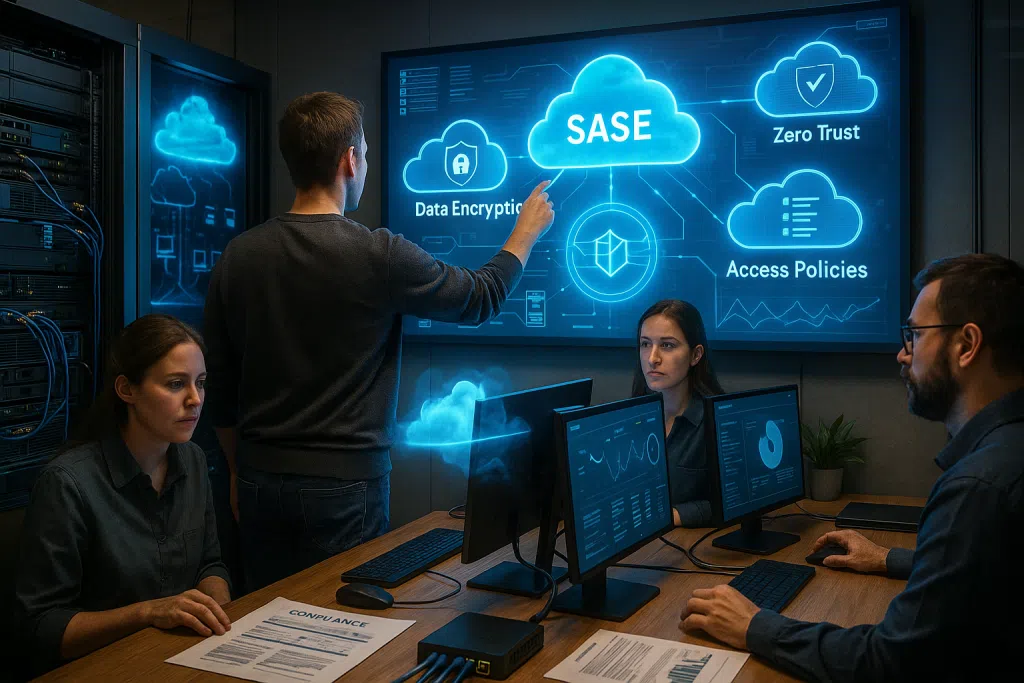Demystifying Cybersecurity SASE: What Small and Midsized Businesses Need to Know
Business leaders in healthcare, finance, legal, and related fields are under increasing pressure to secure data, protect remote users, and comply with growing regulatory demands. As organizations juggle cloud adoption, hybrid workforces, and evolving threats, the term “cybersecurity SASE” (Secure Access Service Edge) is appearing everywhere. But what does SASE really mean, and how can it help small and midsized businesses (SMBs) achieve better security, compliance, and agility without complexity?
At its core, cybersecurity SASE is a security framework that converges networking and security functions delivered from the cloud. This approach streamlines access, enforces strong cyber protection wherever users work, and helps meet tough standards like HIPAA, PCI-DSS, and more. For SMBs juggling a patchwork of firewalls, VPNs, and compliance checklists, SASE offers the promise of integrated security that’s easier to manage and ready for future demands.
Understanding the real-world meaning of SASE starts with recognizing that legacy network security models were designed for office-based teams. Those tools struggle to safeguard today’s distributed users, cloud apps, and sensitive data moving between devices, offices, and home networks. SASE addresses these gaps by unifying technologies such as secure web gateways (SWG), cloud access security brokers (CASB), Zero Trust Network Access (ZTNA), and next-generation firewalling into one, cloud-based platform.
For regulated businesses, like medical practices, legal firms, and financial advisors, adopting a cybersecurity SASE model supports audit-ready compliance by simplifying how user access, data flow, and threat detection are managed. With SASE, security policies travel with users and data, no matter the device or location, which directly maps to HIPAA and other regulatory requirements for continuous protection.
This approach also supports remote or hybrid employees. Traditional VPNs are slow and can become bottlenecks. SASE solutions, however, authenticate users at every connection and evaluate their access in real time, using Zero Trust principles. This makes it much harder for attackers to slip inside your network, even if credentials get leaked or devices are stolen.
If your organization is struggling to keep up with evolving threats, compliance mandates, or sprawling IT tools, exploring cybersecurity SASE could be the most impactful step to future-proofing your digital infrastructure. Not sure where to begin, or whether SASE is right for your operation? Book an initial Discovery meeting with Blueclone Networks to discuss your organization’s security posture and compliance challenges: Book an initial Discovery meeting
Laying the Groundwork: Steps to Move Toward Secure Access Service Edge
Migrating to a secure access service edge is not a one-size-fits-all endeavor. Each business has unique infrastructure, users, compliance standards, and risk tolerances. However, there is a tried-and-tested pathway that organizations can follow to unlock the benefits of SASE in a practical, risk-managed way:
Assess and Map Current Security and Network Assets
Start with a detailed inventory: document your existing firewalls, VPNs, endpoint protections, third-party cloud services, and compliance workflows. Understand where sensitive data resides, how it flows, and which users (internal or external) need access. This step sets a baseline for integrations and identifies gaps where SASE can add immediate value.
Clarify Your Cybersecurity Compliance Requirements
Regulatory frameworks such as HIPAA, FINRA, or PCI-DSS influence what security controls are needed. Review requirements for data protection, tracking user access, safeguarding patient or client information, and maintaining audit trails. SASE architectures can automate many compliance checks and reporting procedures when properly configured.
Prioritize Use Cases and Pain Points
Is your primary goal to protect remote workers, simplify cloud access, or enhance threat detection across locations? For instance, healthcare providers often focus on encrypting electronic health records and monitoring cloud access, while law firms prioritize document confidentiality and secure collaboration with clients. Pinpoint two or three critical challenges and align your SASE rollout to address them step by step.
Research the Best SASE Solutions for SMBs
Don’t get swept away by large enterprise offerings with features you don’t need. Today’s top SASE providers, including those vetted by Gartner, offer modular solutions. Leading options include providers like Netskope, Cisco Umbrella, and Palo Alto Networks Prisma Access, all featured in recent Gartner SASE Magic Quadrant reports. However, working with a managed IT partner like Blueclone Networks ensures solution selection considers your budget, compliance scope, and future growth plans.
Design a Transition Plan and Pilot Test
Rather than a rip-and-replace, overlay SASE tools with existing network protections and migrate user groups incrementally. Test remote logins, cloud app access, and compliance reporting in a controlled setting before broader rollout. Gather feedback, fine-tune policies, and ensure a smooth experience for everyday users, your teams are far more likely to embrace change when disruptions are minimized.
Build a Continuous Improvement Mindset
SASE implementation does not end at deployment. Security threats evolve, compliance rules change, and business technology progresses. Use your SASE security framework to monitor for new vulnerabilities, gather analytics, and refine configurations on a regular schedule.
Following these steps not only positions organizations to benefit from modern cybersecurity but also eases the compliance burden and future-proofs your network for continued business growth.
Core Components of the SASE Security Framework: What Makes It Different?
Moving beyond buzzwords, the SASE security framework is defined by several integrated security and networking technologies working in concert, usually delivered as cloud-based services. Understanding how these layers interact, rather than focusing on any one feature, helps demystify why SASE security is gaining adoption in regulated industries.
Zero Trust Network Access (ZTNA):
ZTNA enforces the principle that “trust is never implicit.” Users and devices must authenticate and prove their legitimacy with every connection. This greatly reduces lateral movement if an attacker compromises a credential or device. ZTNA is especially critical for remote workers, vendors, or contractors accessing sensitive files and systems.
Secure Web Gateway (SWG):
These services monitor and filter web traffic, blocking access to dangerous sites, malicious downloads, or data exfiltration attempts. Rather than bolt-on web filtering, SASE integrates SWG directly so that policies follow users on and off the network, supporting compliance whether staff are in the office, court, or home.
Cloud Access Security Broker (CASB):
CASB controls how users interact with cloud applications (Microsoft 365, Google Workspace, CRM tools, etc.), detecting risky activity or unauthorized sharing in real-time. This is vital as even basic SaaS platforms can be a vector for data leaks or accidental HIPAA violations. CASB visibility is built into leading SASE offerings.
Next-Generation Firewalling
Classic firewalls guard the edges of corporate networks, but SASE takes firewalling to the cloud, inspecting traffic as it traverses multiple sites, data centers, and devices. This enables uniform policy enforcement and threat blocking across an entire organization, regardless of employee location.
Data Loss Prevention (DLP):
DLP features identify sensitive information, such as medical records, financial account data, or customer files, and block or flag attempts to move that information outside approved channels. For compliance-heavy sectors, DLP is integral to avoiding costly breaches and meeting data retention requirements.
Secure SD-WAN (Software-Defined WAN):
While traditional WAN architectures struggle with increasing cloud and remote traffic, SASE leverages SD-WAN to intelligently route connections for optimal performance and security. It’s a foundation for always-available service, application reliability, and resilience against outages.
What truly sets SASE network architecture apart is the convergence of these layers into a single cloud-managed dashboard, offering clearer oversight and more responsive governance. Instead of managing ten tools or relying on scattered logs for compliance audits, organizations can centralize monitoring, incident response, and policy making, saving time and reducing blind spots.
Looking for a tailored approach or a more detailed evaluation of how SASE network architecture could serve your unique workflow? Schedule time with Blueclone Networks to build a migration roadmap: Book an initial Discovery meeting
Addressing Regulatory Compliance With Cybersecurity SASE
For SMBs operating in healthcare, finance, law, and pharmaceuticals, regulatory compliance is more than a legal requirement – it’s a critical business risk. Breaches or audit failures result in severe penalties, loss of reputation, and legal actions. Cybersecurity SASE becomes a force multiplier for compliance by embedding many necessary controls directly within the network layer.
HIPAA, HITECH, and Medical Data Protection
SASE integrates encryption, access controls, and detailed audit logs, simplifying the requirements for HIPAA compliance. With SASE, health data remains encrypted in transit and at rest, and every user access is authenticated and recorded, supporting vital HITECH rules as well. These controls allow providers, pharmacies, or telehealth practices to show evidence of best practice in audits or investigations.
PCI-DSS and Secure Payment Processing
For organizations handling payment card information, SASE enforces continuous monitoring, segmenting credit card data, and blocking unapproved applications from interacting with these datasets. Modern SASE tools provide ready-made templates to meet PCI assessments, reducing the risk of expensive data breaches and streamlining reporting.
Financial Services and Client Confidentiality
Law firms and financial advisors routinely exchange sensitive files. SASE’s CASB and DLP features ensure data cannot be accidentally uploaded to unmanaged devices or shared with unauthorized accounts. Encryption protocols and security policies ensure that client confidentiality is honored in every transaction.
According to a recent ISACA report, companies that consolidate security tools using cloud-based frameworks like SASE see compliance audit times drop by up to 40 percent while experiencing fewer data leakage events. Moreover, the ability to rapidly produce logs and evidence simplifies third-party risk assessments and reduces the scope of external audits.
Finally, SASE frameworks make it easier to enforce evolving regional regulations (e.g., CCPA, GDPR) that affect legal, healthcare, and financial SMBs with clients across state or country lines. By handling data residency, privacy rules, and reporting from a single dashboard, businesses avoid the patchwork headaches of legacy solutions.
Choosing the Best SASE Solutions: What to Evaluate and Common Pitfalls
With dozens of vendors claiming best SASE solutions, selecting the right partner can seem daunting, especially for small or midsize organizations with limited internal IT resources. The stakes are high, as the right choice enhances security and compliance, while a misstep leads to unnecessary cost and ongoing gaps.
Key Assessment Criteria:
- Security Breadth: Does the platform include core SASE functions (ZTNA, SWG, CASB, integrated firewall, DLP, SD-WAN) or does it rely on separate bolt-ons?
- Regulatory Alignment: Are there pre-built compliance frameworks for HIPAA, PCI, FINRA, or specific legal requirements? Is evidence collection for audits straightforward?
- Cloud-Native Architecture: Genuine SASE solutions leverage distributed cloud points of presence, not just cloud-hosted versions of on-premise appliances.
- User Experience: Will the solution slow down remote workers, or does it optimize application access and maintain reliable connectivity?
- Reporting and Analytics: Are dashboards intuitive for non-technical management? Can alerts, policies, and logs be automated and exported in usable formats?
- Flexible Integration: Does the solution integrate with your current identity provider (like Microsoft 365 or Google Workspace), endpoint tools, and industry software?
Common Missteps to Avoid:
- Over-Engineered Solutions: Large enterprises have different requirements. Picking an oversized or unaffordable product often leads to frustration and incomplete deployments.
- Ignoring Vendor Support: SMBs frequently lack “in-house SASE specialists.” Vendor responsiveness and expert guidance during rollout (such as Blueclone’s 24/7 helpdesk) make or break implementation success.
- Weak Security Policies: SASE is only as effective as the policies configured. Lack of real-world testing or customizing to actual workflows can expose gaps and cause user confusion.
- No Compliance Strategy: SASE can automate compliance, but only if requirements are specified during onboarding. Skipping compliance consultation risks audit failures later.
Industry thought leaders, including those cited by CSO Online, recommend involving trusted managed IT providers in solution design and implementation. This approach reduces pitfalls and helps teams quickly see value.
Businesses considering SASE should book an initial Discovery meeting through Blueclone Networks to discuss which platforms and configurations best align with their sector. This ensures the right balance between protection, compliance, user satisfaction, and IT budgets: Book an initial Discovery meeting
Bringing Cybersecurity SASE to Life: Implementation Examples and Best Practices
Deploying a cybersecurity SASE framework impacts all aspects of business IT, users, data, and infrastructure. Real-world examples show how regulated SMBs can use SASE to achieve practical wins:
Case 1: Healthcare Clinic Adopts SASE for Telehealth and Records Access
A growing medical group in New Jersey faced challenges securing patient records for remote staff, while staying compliant with HIPAA rules. The practice piloted SASE with integrated ZTNA and cloud web filtering, giving clinicians secure access to electronic health records and telehealth platforms from any location. Audit logging, real-time threat blocking, and DLP kept patient data private both in transit and at rest. During the following year, the clinic passed two external compliance audits with no major findings.
Case 2: Law Firm Achieves Smarter Remote Collaboration
A mid-sized legal firm struggled with legacy VPN bottlenecks and accidental file sharing risks. By moving to a SASE security model, with CASB and application controls tied to client matter management software, the firm limited file access to authorized attorneys and staff, regardless of device. Secure SD-WAN improved document load times, and built-in analytics made compliance reports available on-demand for client audits.
Case 3: Pharmaceutical Startup Balances Innovation with Security
A startup building AI-powered medical solutions needed to ensure ongoing compliance with both FDA and privacy regulations. The team adopted a modular SASE network architecture, allowing secure developer access to cloud platforms, encrypted data storage, and automatic alerting for abnormal activity. SASE tools helped the company handle sudden remote work transitions without opening up security holes, and detailed compliance reports eased investor due diligence.
Best Practices for Implementation:
- Start with a Pilot Group: Choose a department or workflow to minimize user impact and collect hands-on feedback.
- Leverage Managed IT Expertise: Use certified partners like Blueclone Networks to customize SASE controls for your regulatory and business context.
- Prioritize Zero Trust: Tighten access controls step by step, limiting privileges based on least-necessary access.
- Emphasize User Experience: Communicate the benefits and train users early, focusing on improved speed, fewer login hurdles, and easier app access.
- Automate Compliance: Use pre-built frameworks and reporting tools to collect evidence and respond to auditor requests quickly.
With budgets tight and threats growing, SMBs cannot afford to treat cybersecurity and compliance as an afterthought. Adopting a clear, tested SASE security framework strengthens defenses and reduces the burden on in-house IT, giving organizations a platform for secure, efficient, and scalable operations.
Frequently Asked Questions About Cybersecurity SASE
SASE stands for Secure Access Service Edge. It is a cybersecurity framework that integrates wide area network (WAN) capabilities with security functions, including Zero Trust, cloud access controls, and threat prevention, delivered from the cloud. SASE is especially important for SMBs because it provides consistent security and compliance across office, remote, and hybrid work environments without managing multiple, disconnected tools.
Cybersecurity SASE embeds controls such as strong user authentication, data loss prevention, encryption, and continuous monitoring directly into the network. These features make it easier for SMBs in healthcare, finance, law, and pharmaceuticals to meet HIPAA, PCI-DSS, and other regulatory requirements. SASE simplifies audit preparation by automatically logging access and policy enforcement.
A SASE security framework includes Zero Trust Network Access (ZTNA), Secure Web Gateway (SWG), Cloud Access Security Broker (CASB), cloud-based next-generation firewalling, Data Loss Prevention (DLP), and secure software-defined WAN (SD-WAN). These components work together to protect users, applications, and sensitive information wherever business is done.
Transitioning to a SASE model can range from a few weeks to several months, depending on the size of the organization, current infrastructure, and compliance requirements. SMBs often start with pilot groups and expand as confidence grows. By migrating in phases and working with a managed IT provider, organizations can minimize disruption to staff and daily operations.
SASE benefits both organizations with dedicated IT teams and those using co-managed or outsourced IT solutions. In-house teams gain access to unified management tools, streamlined compliance, and improved security insights, while leveraging external expertise to fine-tune configurations or troubleshoot issues. Co-managed partnerships often provide the best of both worlds, especially for SMBs facing tight deadlines and resource limits.





